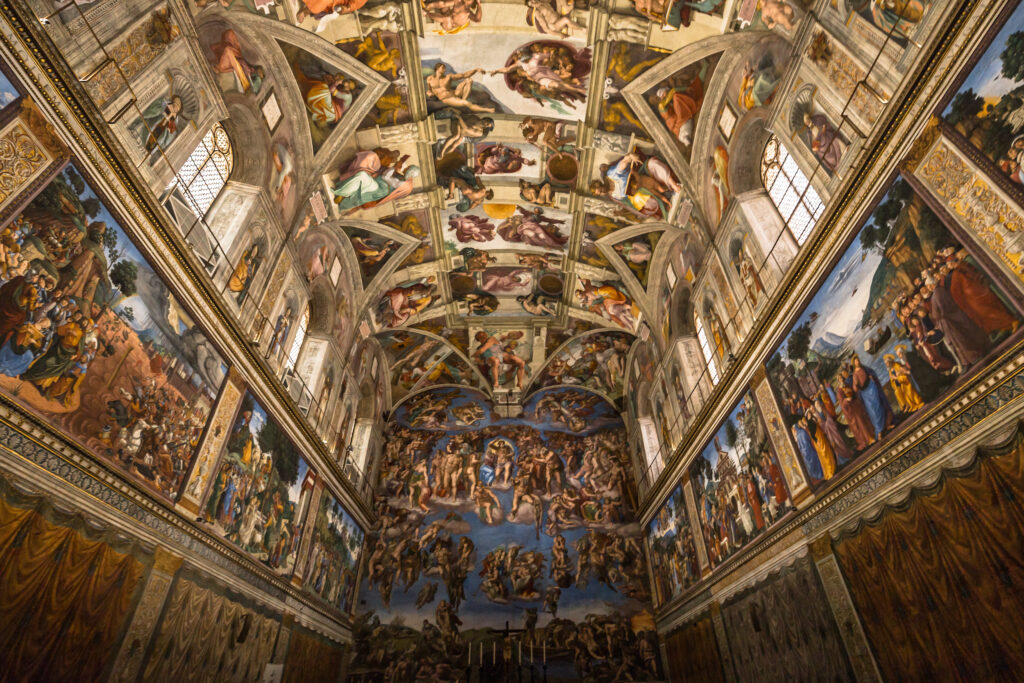Michelangelo di Lodovico Buonarroti Simoni created many astounding works in his lifetime, one of which was his piece on the ceiling of the Sistine Chapel. This astonishing piece must have taken him years to finish.
It took Michelangelo four years to paint the Sistine Chapel. Michelangelo was a famous sculptor at the time, not a painter. However, Pope Julius II was convinced that Michelangelo should do a small painting in the chapel. Michelangelo not one to shy from a challenge convinced the Pope to let him paint the entire ceiling. Twenty years later, he painted The Last Judgement on the Sistine Chapel’s altar.

You can read more below about how Michelangelo painted the ceiling of the Sistine Chapel, the different images he painted, and the second time he painted the chapel.
Michelangelo Paints the Ceiling of the Sistine Chapel
In 1508 when Michelangelo was commissioned to paint the ceiling of the Sistine Chapel, he had already been working on a piece commissioned by Pope Julius II. That piece was the Pope’s tomb.
As mentioned above, Michelangelo wasn’t a painter, so how exactly did he get the gig? Well, it all had to do with the architect who was working on St. Peter’s Basilica.
Donato Bramante was the architect who designed St. Peter’s Basilica and he schemed with Michelangelo’s rival, Raphael. The two convinced Pope Julius II to commission Michelangelo to paint the ceiling of the Sistine Chapel.
Their argument was quite simple. As Giorgio Vasari recalled in his book Lives of the Artists, Bramante told the pope that it was a bad omen to continue with the construction of the tomb because it could be seen as an invitation to death.
Bramante then managed to say to Pope Julius II that it would be a better idea to have Michelangelo paint the vaulting of the Sistine Chapel. Vasari goes on further to say “Michelangelo tried every means to avoid it, and recommended Raphael, for he saw the difficulty of the work, knew his lack of skill in coloring, and wanted to finish the tomb.”
Michelangelo’s efforts were futile because the Pope insisted that he paint the vaulting and what the Pope wants, the Pope gets. Thus, Michelangelo learned to mix colors and paint.
He constructed his own system of platforms to paint on because he did not like the scaffold that Bramante made for him. Contrary to the popular belief that Michelangelo painted the Sistine Chapel laying down, he did it standing up.
You can watch the below Ted Talk video about the entire story surrounding Michelangelo’s painting of the Sistine Chapel.
What He Painted on the Ceiling of the Sistine Chapel
Michelangelo’s painting on the ceiling of the Sistine Chapel is known as one of the greatest pieces of artwork in history. His foundation for his paintings was the Book of Genesis from the Old Testament of the Bible.
Michelangelo split the fresco into nine different scenes that are framed by painted architectural pillars. The very first painting in the series is the creation of the universe where God separates light from dark.
The second and third paintings are still the creation of the Universe with The Creation of the Sun, Moon, and Planets and The Separation of Land and Water. Then he moves onto maybe the most noted painting in the series, The Creation of Adam.
The central painting of the series is The Creation of Eve. Then Michelangelo shows the fall of man through the painting The Fall and Expulsion.
The last three paintings of the series all surround the story of Noah’s Arch with The Sacrifice of Noah, The Great Flood, and The Drunkeness of Noah.
On top of these nine scenes, there are ten paintings of the prophets and the sybils that predict the coming of Christ in the Catholic faith and sixteen paintings of the ancestors of Jesus.
Michelangelo’s Second Undertaking
As mentioned above, Michelangelo created a second painting in the Sistine Chapel over twenty-years after he finished his vaulted ceiling work. It was in 1534, shortly before his death, that Pope Clement VII commissioned Michelangelo to complete a second painting titled The Last Judgement.
After Pope Clement VII’s death, Pope Paul III made sure that Michelangelo completed the work. It took him over seven years to complete the painting that showed the Second Coming of Christ.
Michelangelo’s work in the Sistine Chapel is seen as the epitome of High Renaissance work along with Da Vinci’s The Last Supper.